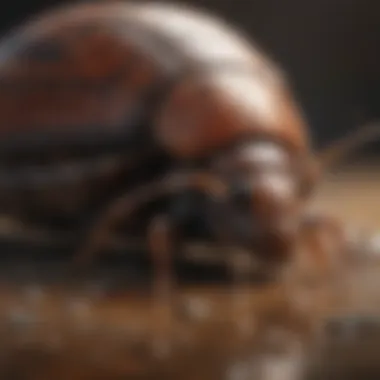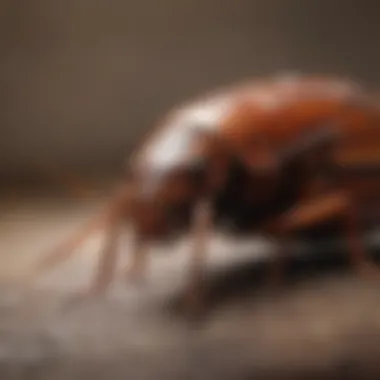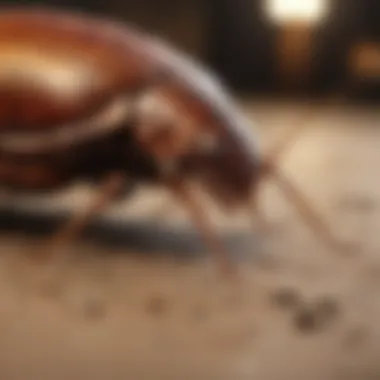Natural Solutions to Effectively Eliminate Cockroaches


Intro
Cockroaches are among the most resilient pests that can invade homes, causing both health concerns and sheer annoyance. While many might rush to the nearest store for chemical-laden sprays, there are natural methods that can tackle these unwelcome invaders effectively. This article aims to shed light on environmentally friendly alternatives, thereby providing insight into the various effective natural ingredients and practices that work against these tenacious insects.
The discussion will delve into cockroach behavior, offering readers deeper understanding crucial for effective pest management. We'll explore different natural ingredients that don't merely mask the issue but address it at its root, while also emphasizing strategic preventative measures. In doing so, we aim to equip you with practical and safe strategies to eliminate cockroaches without resorting to synthetic pesticides.
Whether you're facing a persistent infestation or looking to bolster your home against future invaders, you'll find valuable information to help you regain control of your living space.
Understanding Cockroaches
Cockroaches evoke strong feelings in many people. Whether it’s a sense of disgust or fear, these critters are often viewed as pests that invade our homes. But understanding them is crucial if one wishes to combat their infestations effectively. By taking a closer look at their biology, habits, and the different species, individuals can adopt more informed and natural methods for eradication.
Knowing the nitty-gritty of cockroach biology might seem like diving into the deep end, but it holds practical benefits. For starters, understanding why these creatures scurry about can inform better strategies for both removal and prevention of future infestations. Cockroaches are resilient and have been around for hundreds of millions of years, which means they have adapted remarkably well to changing environments. Recognizing their habitats and behaviors helps create responses that are tailored and effective.
When discussing the interplay between nature and pest management, one can’t ignore the species involved. Each type of cockroach comes with its own quirks and characteristics, requiring distinct methods of control. This knowledge parallels the importance of using natural solutions. With eco-friendly approaches gaining traction, understanding the biology and species of cockroaches is an indispensable tool in one’s pest control arsenal. It’s not just about getting rid of the pests but doing so in a responsible manner that respects the environment.
Thus, we embark on a deeper dive into the biology and behavior of these insects, as well as getting to know some of the common species that might invade your space. Equip yourself with valuable insights that can steer you clear of future issues and foster a healthier living space.
Biology and Behavior of Cockroaches
Cockroaches’ biology is intriguing, frequently noted for their capacity to thrive in adverse conditions. They have a flat, oval-shaped body which allows them to hide in tiny crevices. With six legs and long antennae, they move quickly and can seem like a flash in the pan, making it difficult to catch them unawares. This streamlined design is not just for show; it plays a vital role in their survival.
Their habits reveal much about their life cycles and preferences. Typically nocturnal, they prefer to scuttle around when it’s dark, often feeding on organic material like scraps of food. This omnivorous diet can sometimes make them the unwelcome guests, especially in kitchens. While they may seem harmless, it’s worth noting that they can carry pathogens and allergens that might affect household health.
Common Species of Cockroaches
Understanding the various species of cockroaches is fundamental in identifying and addressing specific infestations in a targeted manner. Below, we delve into three common types – each with distinct traits.
American Cockroach
The American cockroach is often regarded as one of the larger cockroach varieties, growing up to two inches in length. Known for its brownish-red color and a yellow band around its thorax, this species thrives in warm, humid environments. They mainly inhabit basements, sewers, and, believe it or not, restaurants.
What's particularly crucial about the American cockroach is its capacity to fly, although it’s not particularly graceful while doing so. Its ability to traverse various environments only adds to its presence as a resilient creature. This species is noteworthy for its potential to carry diseases that impact hygiene, making it essential to target natural eradication methods specific to this variety.
German Cockroach
In stark contrast, the German cockroach is much smaller, usually no more than an inch long. This species has a distinct tan or light brown coloring with two dark stripes on its back. It’s one of the most common species found in homes and restaurants, often appearing where food is stored or prepared.
The rapid reproduction rate of the German cockroach makes it a persistent problem for home and business owners alike. A single female can produce several egg cases in her lifetime, each containing dozens of little cockroaches. Because of this, it becomes critical to implement natural methods aimed at disrupting their breeding cycle to keep them at bay.
Oriental Cockroach
Sturdier in appearance, the Oriental cockroach is often noted for its shiny black or dark brown coloration. It’s commonly found in basements, drains, and other damp environments. Although it usually ranges from one to one and a half inches in size, it lacks wings, which makes it less mobile compared to its counterparts.
A benefit of the Oriental cockroach is that it tends to be less adaptable to dry environments, a fact that can be exploited when seeking natural control methods. It’s vital to recognize their presence by their distinctive odor and droppings, which often indicate larger infestations. This understanding can help in best practices for managing and reducing their numbers effectively.
By illuminating the world of cockroaches, from their biology to the species, one can take more confident steps in dealing with these pesky visitors. Knowledge is your best friend in crafting a pest-management plan that respects both your health and the environment.
Identifying Signs of Infestation
Recognizing the signs of a cockroach infestation is crucial for timely intervention. Without awareness of the various indicators, these pests can multiply quickly, leading to larger problems down the line. It’s essential to be vigilant, as early detection can often turn the tide against these unwelcome guests. In this section, we'll explore visual and olfactory cues that signal cockroach presence, which provide insight into the severity of the infestation and aid in deciding the best course of action.
Visual Indicators


Visual indicators of a cockroach infestation can vary, but two primary signs often come to light—droppings and egg cases. Spotting these indicators can put you a step closer to reclaiming your space.
Droppings
Cockroach droppings are one of the most telling signs that these creatures have decided to make your home their own. Their droppings resemble small dark pepper flakes, often found in areas where cockroaches frequent, such as under sinks, behind appliances, or in cabinets. Knowing where to look can save you a great deal of time and trouble.
The key characteristic of droppings is their size and color. They tend to be about the size of a grain of rice, and their presence can indicate not just individual roaches but a probable population residing nearby. This is where the usefulness of droppings shines—it's a direct visual cue to act upon.
Unique to cockroach droppings is also the potential health risk they pose. Beyond being a nuisance, their droppings can trigger allergies and asthma in sensitive individuals. This makes them a pivotal point of concern when addressing pest control.
Egg Cases
Egg cases, also known as oothecae, can be a further indication of infestation. These casings can house many developing roach embryos—sometimes up to 40 eggs per case—making them crucial markers to detect. They are usually brownish, oval-shaped, and have a leathery appearance. You might find them tucked away in corners, behind furniture, and in other nooks and crannies that provide dark shelter.
Egg cases stand out as they often symbolize a larger issue at hand; finding one can suggest that more than a few roaches are alive and thriving in your home. Their distinctive quality makes them easy to identify, which can help you act quickly.
Unlike droppings, which can sometimes be mistaken for other types of debris, egg cases have a clear connection to reproduction and expanding populations. This unique feature allows you to gauge how advanced the infestation may be. Tackling this issue early on is key to halting it in its tracks.
Olfactory Cues
While visual signs are crucial, olfactory cues should not be underestimated. Cockroaches emit a unique odor reminiscent of oily or musty scents. This odor is often more noticeable in heavily infested areas. When you catch a whiff of something unusual, it may be an alert from the roach community that it’s high time to take action.
Being aware of these cues can be beneficial not just in identifying an infestation but also in monitoring areas where control measures might need to be implemented more rigorously. This adds another layer to your monitoring methods, ensuring you're not just reacting but staying proactive in pest management.
"Detailed observations lead to effective interventions. A keen eye can change the game against infestations."
Recognizing these signs not only helps distinguish between a casual roach sighting and an infestation but also informs your next steps. Knowing what to look for enables a focused approach—whether you’re opting for natural methods discussed later or calling in the professionals.
Keep in mind that these pests might be lurking quietly, often late at night, so maintaining awareness in your environment is essential for a successful eradication strategy.
Natural Remedies for Cockroach Control
Eliminating cockroaches through natural means not only provides a safer environment but also supports a more sustainable lifestyle. Traditional pesticides can be harmful to both the individuals using them and the ecosystem. Thus, natural remedies offer effective solutions with fewer health hazards and environmental impact. The use of natural methods not only serves to rid your home of these unwelcome pests but also empowers individuals, making them more conscious of the substances they choose to use in their living spaces.
Boric Acid
Boric acid serves as a potent yet natural remedy for cockroach control. Its effectiveness stems from its unique properties as both an insecticide and an insect growth regulator. When roaches consume boric acid, it disrupts their digestive systems, leading to eventual death. Additionally, it is non-toxic to humans and pets when used correctly, making it a safe option for households.
The application is straightforward; sprinkle boric acid in areas where cockroaches frequent, such as behind appliances or under sinks. However, caution is key. Always ensure it is out of reach of children and pets, as ingestion in large quantities can lead to adverse health effects.
Diatomaceous Earth
Diatomaceous earth is another remarkable natural remedy to mitigate cockroach infestations. This fine powder is made from crushed diatoms, which are tiny fossilized water plants. When cockroaches come into contact with it, the powder adheres to their exoskeletons, causing them to dehydrate and eventually die. This method is not only effective but is also safe for humans and pets, making it an excellent choice for households.
To utilize diatomaceous earth, dust it in places where cockroaches are likely to walk. This could be right behind cabinets or along baseboards. The only downside is that it’s less effective in damp conditions, so it’s important to keep those areas dry as much as possible.
Essential Oils
Essential oils have gained popularity in pest control, thanks to their natural properties that deter cockroaches and other insects. Among the various options, peppermint, tea tree, and eucalyptus oils stand out for their effectiveness and pleasant fragrances.
Peppermint Oil
The refreshing scent of peppermint oil is about more than just an uplifting aroma; it acts as a powerful natural repellent for cockroaches. Its strong fragrance can overwhelm the sensitive sensory systems of these pests, driving them away from treated areas. Besides, peppermint oil is widely considered a natural and non-toxic solution, making it a go-to for households concerned about chemical exposure.


The unique feature of peppermint oil lies in its dual action: not only does it repel, but it can also be blended with other ingredients to create homemade sprays. However, it’s worth noting that while it may deter roaches, it might not kill them outright, so using it as a preventative measure is more effective.
Tea Tree Oil
Tea tree oil is well-renowned for its antiseptic and antifungal properties, but it’s also an excellent natural remedy for pest control. Its strong scent can mask the pheromones that cockroaches use to communicate, disrupting their social behavior and leading them to flee.
What sets tea tree oil apart is its ability to tackle not only cockroaches but other pests too, making it a versatile addition to your natural pest management toolkit. Though effective, its strong smell may be off-putting for some, and applying it may require multiple sessions for maximum effectiveness.
Eucalyptus Oil
Eucalyptus oil, with its strong and invigorating fragrance, not only enhances the ambiance of a room but also aids in pest control. Similar to peppermint and tea tree oils, its scent serves as a deterrent to cockroaches. Eucalyptus oil can mask food smells that attract roaches, making it an excellent choice for kitchens.
The major advantage of eucalyptus oil is its long-lasting effects, as its aroma lingers longer than some other essential oils. However, the potency of its fragrance may not be suitable for everyone, as some find it too strong or even irritating, so moderation is recommended.
Soap and Water Solution
Mixing soap with water provides a simple yet effective remedy for tackling cockroaches. When sprayed directly, soap disrupts their outer protective waxy layer, leading to dehydration and ultimately death. This solution is also quite safe, as soap is commonly found in households.
To create this mixture, blend water and a few drops of dish soap in a spray bottle. Spray this solution in areas where you suspect roach activity. The only drawback might be that this method may not provide long-term solutions, so pairing it with other remedies could maximize effectiveness.
Making Natural Traps
Creating natural traps is a crucial part of effectively tackling cockroach infestations. Not only does it offer a more humane approach to pest control, but it also minimizes the use of harmful chemicals. Cockroaches are known to be persistent critters, so having traps that attract and eliminate them can help in controlling their population in your home. These traps can be an additional measure alongside preventative techniques and natural remedies, ensuring a comprehensive strategy against these unwelcome guests.
Homemade Baits
Sugar and Baking Soda
The combination of sugar and baking soda is a well-known homemade bait that has shown promise in attracting and eliminating cockroaches. Cockroaches have a sweet tooth, and the sugar acts as an effective lure. Once they consume this enticing mixture, the baking soda reacts with the acid in their stomach, ultimately leading to their demise. This trap shines due to its simple ingredients and ease of use.
A key characteristic that makes sugar and baking soda popular is its accessibility; both ingredients are common in many homes, making it a go-to option for those looking to handle a cockroach problem swiftly. However, it’s worth noting that while this bait is effective, it might not cater to very large infestations. Sprinkling it in areas where you suspect roaches lurk can lead to some success, though it’s best employed as part of a broader strategy.
Peanut Butter and Boric Acid
Another noteworthy homemade bait involves combining peanut butter with boric acid. The strong aroma of peanut butter is a major draw for cockroaches. When they take the bait, the boric acid, which is minimally toxic to humans and pets when used correctly, interferes with their digestive system. This method has been favored for its efficacy in eliminating roaches over time.
The unique feature of this combination lies in its dual action; not only does the peanut butter attract, but the boric acid ultimately reduces the cockroach population. However, caution is necessary given the use of boric acid. While it’s less harmful than many commercial pesticides, it’s still crucial to keep it out of reach of children and pets to avoid any unintended ingestion. Therefore, while it is a beneficial tool to consider, responsible placement is key.
Using Bottles and Bowls
Using simple household items like bottles and bowls can also prove effective in trapping cockroaches. A common method involves filling a shallow dish with water mixed with a bit of detergent and placing it near infested areas. The dish acts as a trap; cockroaches, attracted by the water, fall in and cannot escape. Alternatively, you can cut the top portion off a plastic bottle, add bait inside, and place it upside down. The cockroaches can enter but find great difficulty getting out.
This approach is not only economical but also simple to execute, making it a favored method among many households dealing with cockroach problems. It shows how creativity can offer solutions without resorting to chemicals that might harm other inhabitants in your home.
Preventative Measures
Preventing a cockroach invasion is often cheaper and less nerve-wracking than dealing with a full-blown infestation. Why? Well, addressing cockroach problems before they start is key to a clean and healthful environment. If you can make your home less attractive to these unwelcome guests, you'll stand a much better chance of keeping them at bay.
Proper Food Storage
To the casual observer, the chaos of daily life can make it seem impossible to keep food organized properly. But when it comes to pest prevention, mastering food storage is like putting a lock on your kitchen. Cockroaches, often the opportunistic diners they are, can thrive on even the tiniest morsels—leftover crumbs under the couch or an open packet of snacks that didn’t get sealed back up tight.
- Use airtight containers: Store all your food in sealed plastic or glass containers. Not only does this prevent both cockroaches and other pests from accessing your food, but it also keeps your snacks fresher for longer.
- Refrigerate perishables: Leaving food out, even if it’s just for a little while, is like sending an invitation to cockroaches. Make sure that leftovers, fruits, and vegetables are well-stored in the fridge when not in use.


By adopting these practices, you not only make it tough for cockroaches to get their meal but also create a tidier kitchen space. It's a win-win!
Sealing Entry Points
Imagine your home as a fortress. No fortress is complete without its defenses. Cockroaches are sneaky; they can slip through the tiniest cracks and gaps that may escape your notice. If kinks go unchecked, they can turn your sanctuary into a breeding ground.
- Inspect regularly: Check around doors, windows, and the foundation of your home. Look for any potential entry points that might not be obvious—cracks in walls, gaps in window frames, or holes around plumbing.
- Use caulk and weather-stripping: These two heroes in the fight against pests create a seal that is nearly impenetrable. Seal gaps around pipes, mail slots, and even the edges of your foundation.
- Install door sweeps: A simple door sweep on exterior doors can make a huge difference. It blocks the gap beneath the door, preventing roaches from sneaking inside.
Taking steps to seal entry points might seem tedious, but the payoff is significant. Your efforts will go a long way in fostering a roach-free environment.
Regular Cleaning Practices
Keeping a clean home is not just about aesthetics—it's a front line defense against cockroaches. Regular cleaning can knock back their population before they even think about moving in. A dusty shelf might not seem like much, but to a cockroach, it could be an invitation.
- Sweep and vacuum: Make sure to regularly clean floors and surfaces where crumbs and food residue can accumulate. Don't forget to include hard-to-reach places like behind appliances, under the sink, and among corners.
- Wipe down surfaces: A quick wipe-down with soapy water or a natural cleaner can help remove food traces and moisture that might attract pests. Consider using a vinegar solution to deter cockroaches without any harsh chemicals.
- Declutter: Reducing clutter means fewer hiding spots for cockroaches. Make a habit of regularly organizing spaces and tossing out what you no longer need.
In summary, consistent cleaning paired with food storage and sealing entry points is both the sword and shield against cockroaches. By implementing these preventive strategies, you're well on your way to creating a cockroach-resistant home.They’ll be less likely to even bother knocking at your door.
"An ounce of prevention is worth a pound of cure."
Adopting preventative measures might not produce immediate results, but they lay the groundwork for a cockroach-free future. The key is staying vigilant.
By embracing these practices, you empower yourself and your home, making it far less inviting for those unwelcome critters.
Environmental Considerations
When it comes to pest control, the environmental implications of your chosen methods cannot be taken lightly. This section aims to shine a light on the environmental considerations surrounding cockroach elimination, underlining the significance of opting for natural methods over chemical treatments. For those who care about the well-being of our planet and its inhabitants, understanding this topic is vital.
Impact of Chemical Treatments
Chemical pesticides have been the go-to solution for many homeowners facing cockroach infestations. However, the reality is far from desirable. These substances, while effective in the short term, can lead to a slew of environmental problems. For example, chemicals can seep into the soil, affecting local flora and fauna. Additionally, due to their toxicity, they pose a risk not only to the cockroaches targeted but also to family pets and even small children.
- Ecosystem Harm: The use of chemicals can upset local ecosystems. Beneficial insects, such as bees and ladybugs, may be harmed unintentionally, leading to a balancing act gone awry.
- Health Risks: Chemical treatments can leave residues that linger long after application, raising concerns about indoor air quality and long-term health implications for inhabitants.
- Water Pollution: Improper disposal of chemical containers or runoff can lead to contamination of local water supplies, further affecting wildlife.
In light of these issues, it’s crucial to consider methods that prioritize sustainability and safety. Choosing natural alternatives not only benefits your home but also the environment.
Benefits of Natural Solutions
Natural solutions to eliminate cockroaches offer benefits that extend beyond effective pest control. Embracing these alternatives contributes to a healthier home and a more sustainable world. Here are a few notable advantages:
- Safety for Humans and Pets: Natural ingredients, such as boric acid or essential oils, provide a safer option without the toxic backlash commonly associated with chemicals. Using these alternatives means peace of mind, especially for those with pets and children.
- Eco-friendly: Many natural solutions are biodegradable and less harmful to ecosystems. In fact, some methods even encourage beneficial insects to thrive in your garden instead of harming them.
- Cost-Effective: Often, natural methods can be made with common household ingredients, making them budget-friendly. For example, a simple mixture of sugar and baking soda can serve as an effective bait without emptying your wallet.
- Sustainability: By opting for these natural treatments, you contribute to a cycle of sustainability. You’ll be reducing the demand for chemical pesticides, thereby allowing for the greater preservation of biodiversity.
When practicing cockroach control through natural methods, you’re not just tackling a pesky problem; you’re actively engaging in a responsibility that extends beyond your home.
"The choices we make in pest control reflect our values toward the environment and our health."
End
The journey through the various natural methods to eliminate cockroaches has uncovered not just practical solutions, but also vital considerations for a sustainable and healthy living environment. Cockroaches, as pesky intruders, present health risks and discomfort to many homes. Understanding their behavior and biology is not merely academic; it’s the key to addressing infestations without the overreliance on harmful chemicals.
Natural alternatives, such as boric acid, diatomaceous earth, and essential oils, provide effective eradication while preserving indoor air quality. Moreover, making homemade traps and ensuring rigorous cleaning routines can significantly mitigate the chances of these unwelcome guests taking up residence.
It is imperative to acknowledge the environmental impacts of pest control methods. Chemical treatments often lead to detrimental side effects on ecosystems and human health, which is why the shift toward natural solutions is not just an option but a necessity. The blending of practical knowledge with eco-friendly practices equips homeowners and pest enthusiasts alike with the tools they need to effectively combat pests while being stewards of the environment.
Future Considerations for Pest Control
Looking ahead, a few key elements come into play regarding pest management strategies. First, ongoing research into natural pesticides can yield even more advanced tools for managing cockroach populations gently. Next, education about preventative measures is crucial; educating the public on proper food storage and sealing of entry points can mitigate future infestations.
Furthermore, promoting awareness about the benefits of maintaining cleanliness and the potential dangers of neglect can foster a more proactive approach among communities.
In addition, as we foster a deeper understanding of pest behavior and control methods, safeguarding not only our homes but also our planet will pave the way for healthier futures.







